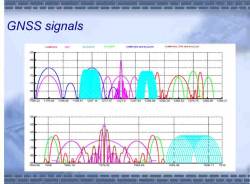
Late last year, I attended China’s only government-sanctioned international conference on GNSS and visited a number of local companies. I came to one conclusion: The world of GNSS is about to change, and China will have a lot to do with that.
Consider this: China has launched its own GNSS system, Compass/Beidou. It has liberalized policies on GNSS receivers and navigable digital maps. It is already one of the world’s largest economies with enormous capital reserves and steadily-growing disposable income in the hands of millions of citizens.
Late last year, I attended China’s only government-sanctioned international conference on GNSS and visited a number of local companies. I came to one conclusion: The world of GNSS is about to change, and China will have a lot to do with that.
Consider this: China has launched its own GNSS system, Compass/Beidou. It has liberalized policies on GNSS receivers and navigable digital maps. It is already one of the world’s largest economies with enormous capital reserves and steadily-growing disposable income in the hands of millions of citizens.
As a GNSS player, the People’s Republic of China (PRC) arouses interest and concern on at least four levels: as a service provider (compatible or incompatible?), as an equipment manufacturer (competitor or partner?), as a product designer and technology distributor (re-engineering or innovation?), and as an enormous market of largely untapped potential (closed or open?).
In their own fashion, of course, every other GNSS provider brings the same set of questions and, like China, a distinct way of answering them. The real questions are what lessons has China learned from the world’s 30-year experience with GNSS and how will it apply those lessons to the nation’s emerging role of GNSS provider, designer, manufacturer, and marketplace.
One measure of that can be taken from increasingly public, though still carefully scripted statements on the subject from Chinese public officials and industry leaders.
NaviForum: Beidou’s Debut
The Shanghai Navigation Forum (NaviForum) bills itself as the only international GNSS exhibition and conference officially approved by the Chinese government, which is also deeply involved with the organization of the event.
(Sponsors included the Department of High & New Technology Development and Industrialization, Ministry of Science & Technology (MOST); Department of Map Management, State Bureau of Surveying & Mapping (SBSM); and the Science & Technology Commission of the, Shanghai Municipal People’s Government.)
Its fourth annual staging in December 2007 drew more than 700 attendees, with 29 percent coming from outside China, according to conference organizers. And it was, in many respects, a coming out party for Compass, which is also widely known by its Chinese pinyin (alphabetized) name, Beidou.
As with GPS and Russia’s GLONASS systems, Compass began as a military program operated by China’s defense mapping agency and, as with those other two GNSSes, will continue to have a military component. Several geostationary satellites were launched beginning in 2000, broadcasting on a center frequency of 2491.75 MHz in a small slice of spectrum allocated for radiodetermination/mobile satellite.
Until late in 2006, it appeared that Compass/Beidou would remain a regional system, augmenting full-fledged GNSSes. A 2003 agreement committed China to investing €200 million ($290 million) in cooperative development of the European Union’s Galileo system.
In October 2006, however, China announced that it would build a full-fledged GNSS system that would transmit signals in the L1 band where GPS and Galileo military and public safety services are located. Then, last April 14 China launched a middle-earth orbiting (MEO) satellite and quickly began broadcasting signals.
The Compass signals were soon analyzed by researchers at Stanford University and Belgian GNSS receiver manufacturer Septentrio, who published articles in the July/August 2007 issue of Inside GNSS describing their findings.
Subsequently, in a break with a previously restrained public posture on the subject, several representatives from the China Satellite Navigation Engineering Center described the program in some detail at NaviForum 2007. In another session, “New Positioning System,” European and Chinese public and industry panelists focused on Compass. And throughout the conference, Chinese speakers referred repeatedly and favorably to the domestic GNSS system.
Something Old, Something New
Much of the information revealed in the Shanghai meeting merely confirmed what had already been published by outside researchers: L-band signals centered at 1561.098 MHz ± 2.046 MHz (Beidou 1 or B1, overlaying the Galileo E2 band and part of the GPS L1) and 1589.742 MHz (B1-2 on Galileo E1 and the upper portion of GPS L1); 1207.14 MHz ±12 MHz (B2, E5b), and 1268.52 ±12 MHz (B3, on the lower portion of E6).
B1/B1-2 signals would use quadrature phase shift keying (QPSK) and binary offset carrier (BOC) modulations similar to those employed by GPS and Galileo on those frequencies, according to Yang Qiangwen, senior engineer, China Satellite Navigation Project Center (CSNPC, also sometimes referred to as the engineering center) in the Beijing region. The signals will have a pseudorandom noise (PRN) code chipping rate of 2.046 Mcps and a minimum received power level of -163 dBW.
Several of the speakers, however, also provided further insight into Compass and China’s ambitious plans for the system. Ran Chengqi, the CSNPC deputy director speaking in place of the center’s director, Yang Changfeng, told the NaviForum audience that open services would be operated at L1 and L5.
He also emphasized the need for compatibility and interoperability with other GNSS systems, saying, “China will work with the other GNSS providers under UN International Committee on GNSS (ICG) rules.”
“Beidou is a huge investment,” Ran said. “We need to be very careful in its implementation and look at the risks in the market. Our goal is a long-term commitment to users.
He underlined the system’s “strategic role,” adding, “although Beidou has made a fast start, we still need to commit our resources to make sure. We need more open industrial policies,” alluding to the promised publication of a public Interface Control Document (ICD) that would specify Compass’s technical parameters so that receiver manufacturers could build user equipment confidently.
“We have to build up [Compass/Beidou] awareness and our own brand in the world,” Ran concluded. “An open, prosperous, and strong China will develop based on an open, strong, and healthy navigation system.”
In a plenary session speech, Liao Xiao-han, deputy director of High & New Technology Development and Industry, Ministry of Science and Technology (MOST), said, “After completion of Compass, we believe it will be the major supplier of positioning, navigation, and timing [PNT] in China and also a significant supplier of PNT in the world.”
Liao emphasized the need to make Compass “compatible and interoperable with GPS and Galileo” by working to share common frequencies and avoid interference on limited GNSS bandwidth.
Meanwhile, he added, “We are working with Galileo to create synergy,” he said, “We want to expand the PNT footprint.”
According to several speakers, Beidou will be providing a regional service over the east Asia region by 2009 and a global service later at an indeterminate date. Beidou’s open services will be offered without “entrance or authorization fees.”
In the New Positioning System session, Yang reported that the CSNPC would provide an open and free ICD on its website “in the very near future,” admitting, however, that the website was still under development. Compass operators have a “very detailed plan for future beyond 2009,” which would be released along with a launch schedule – also “in the very near future,” he said.
In tests of Beidou’s signals conducted August 21–30, 2007, the CSNPC found an average 0.5 meter residual ranging error and a one-meter sequential error in the MEO satellite’s orbital positions based on comparisons with satellite laser ranging to the satellite. (to see Table 1 and Figure 1, which illustrate this point, download the article pdf above.) The on-board clock error was 5 nanoseconds over 3 hours, and 11 nanoseconds in the course of 24 hours.
Industry on Parade
A well-attended exhibition accompanying the conference drew a couple of dozen Chinese and foreign companies and public agencies. These included the country’s first GNSS company to issue public shares of stock (and the provider of services for the first phase of Beidou), Beijing BDStar Navigation Co., Ltd. Although organizations representing the automotive, portable navigation, and telecom sectors dominated the exhibit, Beijing UniStrong, which plans on entering the U.S. survey market, also was represented.
Underlining the Shanghai region’s generally accepted status as the economic center of China, Chen Kehong, vice-chairman of the Shanghai Municipality’s Science and Technology Commission, described the region’s 14-station differential GPS network.
“In the future, would like to see incorporate multiple [GNSS] systems [into the DGPS network], including Beidou.” Chen said that the regional government would like to see such services based on market rather than planned economy.
“The Shanghai municipal government will move Beidou into the application industry chain,” he added. “We will spare no effort to implement Beidou services and technology development.”
In a corresponding show of bureaucratic support for commercial development, Li Yongxiong, director general of the Department of Map Management, State Bureau of Surveying and Mapping (SBSM), described efforts to liberalize China’s regulatory policies on access to data with which create navigable map databases.
Eleven companies approved by central government to product digital maps with maps currently available from six Chinese companies. These cover every city in China except two, and 95 percent of all of highways, according to Li.
Available mapbases incorporate 5 million points of interest and 1.8 million miles of highways and expressways at 1:10,000 scale. The SBSM is “working very hard on 1:2,000 scale databases in urban areas,” for which the agency would like to create a system to provide real-time updates.
(Articles in future issues of Inside GNSS will return to the subject of China’s domestic GNSS design and manufacturing sector as well as the effect of Compass/Beidou’s development on the world’s other GNSS systems.)





